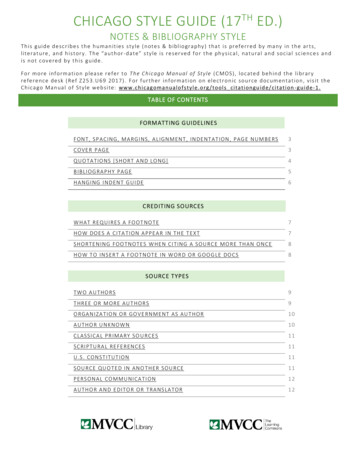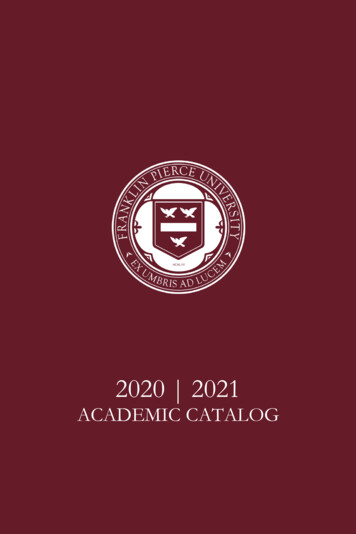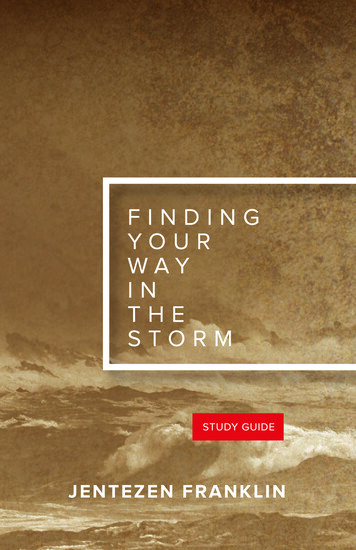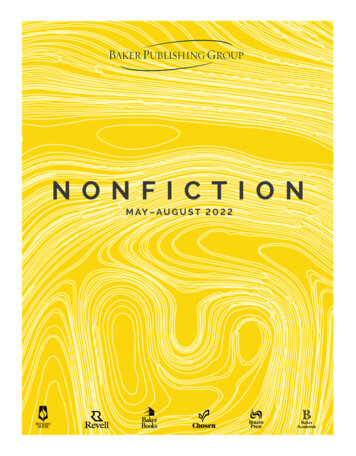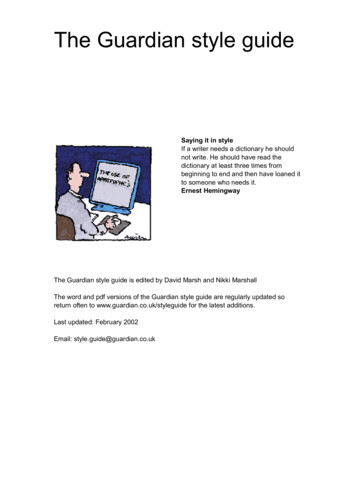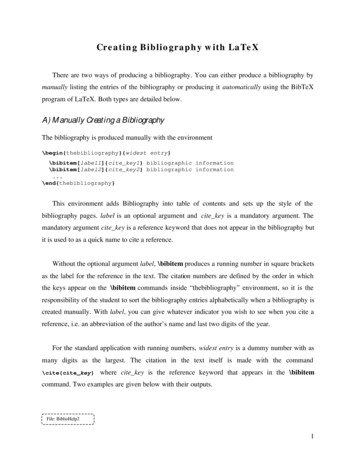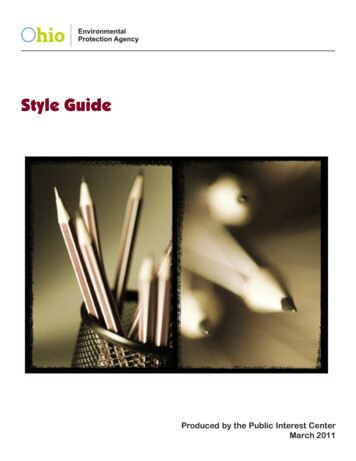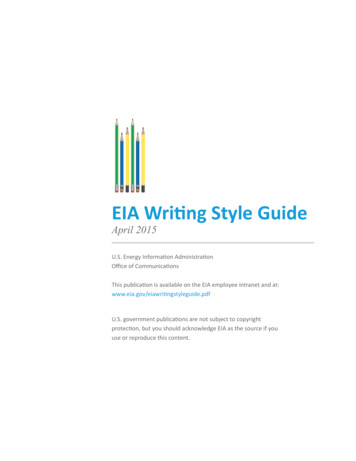
Transcription
FranklinStyleManualA resource for avoiding plagiarism and using APA style (6th ed.)Student Learning CenterPhone: 614.947.6800Toll free: 1.866.341.6206Email: slc@franklin.eduwww.franklin.edu/slcUpdated September 2011
iiDear students and faculty,The Franklin Style Manual is adapted from the Student Learning Center’s earlier APA Guide. Besidesintegrating the latest APA guidelines (as presented in the 6th edition of The Publication Manual for theAmerican Psychological Association, 2010), this manual provides extra discussion of fundamental writingtasks, such as locating sources and avoiding plagiarism. While these additions cannot replace fullresearch and writing guides, like those you will be assigned for courses having a major writingcomponent, the guidelines here should remind you of the key purposes and aims of research writing andacademic work in general, which will help you on the pathway to success for any writing assignment.Our reason for revising Franklin’s APA guide so substantially is that we are a growing institution,regularly developing new majors that bring into our learning community a wider variety of students andfaculty. As discussed later in this manual, the expectations for writing vary more or less with eachdiscipline and course, many of which require minor alterations to Franklin’s chosen standard foracademic papers—that is, the APA guidelines for scholarly publication. In fact, APA has itself left many ofits recommendations open to revision and clarification depending on the purposes and expectations ofparticular writing communities. In order to have the common APA standard serve as a true “go-to”standard for academic coursework, as opposed to just a vague guide for preparing manuscripts, a fullermanual was required, in part, “to get everyone on the same page.” This manual, then, clarifiesexpectations for academic writing at Franklin, identifying where Franklin as an institution diverges fromAPA recommendations and where particular assignments, courses, or instructors may diverge from bothAPA and Franklin-wide recommendations. Whenever you have questions about the material in thisdocument and how it can be applied to particular assignments, you are encouraged to ask yourinstructor and, if further help is required, to contact the tutors at the Student Learning Center:slc@franklin.edu.As a document intended to accommodate a growing, modern university, finally, the Franklin StyleManual should be considered a work in progress. We on the Franklin Writing Team encourage you tosend suggestions for modifications, disagreements with standards, or requests for additions to thefollowing e-mail address: writing@franklin.edu. We will review these submissions regularly as we publishperiodic revisions and updates to the manual itself.Write well!January 20, 2011Daniel SewardLead Faculty, Writing, Rhetoric, and CommunicationDepartment of Humanities and Communication ArtsHeather MaynardAssistant DirectorStudent Learning CenterPhyllis DuryeeLead Faculty, General EducationDepartment of Humanities and Communication ArtsMichael KlinglerProgram Chair, General Education; Interim Department ChairDepartment of Humanities and Communication Arts
iiiTable of ContentsIntroduction . 11. Researching and Writing Responsibly . 21.1 Finding Sources . 2§ 1.1.1 Are you conducting the appropriate kind of research? . 2§ 1.1.2 Are you exploring a variety of media? . 2§ 1.1.3 Are you using the right search tools? . 3§ 1.1.4 Are you recording the right information about your sources? . 31.2 Evaluating Sources . 3§ 1.2.1. Assessing the authority of sources. 4§ 1.2.2. Assessing Web search results . 41.3 Using Sources Effectively . 5§ 1.3.1. Referencing sources in the body of the paper . 5§ 1.3.2. Introducing and positioning sources within a paper . 6§ 1.3.3. Citing references . 71.4 Avoiding Plagiarism with Proper Citation and Quotation . 7§ 1.4.1. Defining and assessing plagiarism. 7§ 1.4.2. Understanding the consequences of plagiarism . 8§ 1.4.3. Determining what needs to be cited . 9§ 1.4.4. Quoting, paraphrasing, and summarizing responsibly . 112. APA Documentation. 172.1 The Basics of APA Documentation . 172.2. Formatting In-text Notes . 18§ 2.2.1. Where to put in-text notes . 19§ 2.2.2. What details to include in in-text notes . 20§ 2.2.3. How to place and punctuate in-text notes . 21§ 2.2.3. When to streamline notes for readability. 24§ 2.2.4. Sources needing in-text notes but no entry on the References page . 252.3 APA Reference Lists . 27§ 2.3.1. Listing books and other non-periodical print publications . 30§ 2.3.2. Listing articles from printed journals, magazines, and newspapers . 32§ 2.3.3. Listing periodical articles from databases and periodical websites. 34§ 2.3.4. Listing Web pages, blogs, reader postings, and e-books . 37
iv§ 2.3.5. Listing audio, video, and multimedia sources . 39§ 2.3.6. Listing reference articles, government documents, and other special genres . 413. APA Document Formatting . 433.1. Format Settings Applied to the Whole Document. 43§ 3.1.1. Page layout settings . 43§ 3.1.2. Paragraph and type settings . 433.2. Standard Parts of an APA Paper. 44§ 3.2.1. Title page . 44§ 3.2.2. Abstract page . 44§ 3.2.3. The body of the paper . 45§ 3.2.4. References page . 46§ 3.2.5. Appendices . 473.3. Formatting Tables, Figures, and Lists . 47§ 3.3.1. Lists. 47§ 3.3.2. Tables and figures . 484. APA Conventions for Grammar and Mechanics . 514.1. Punctuation and Spacing . 51§ 4.1.1. Commas. 51§ 4.1.2. Quotation marks . 514.2. Special Formatting . 51§ 4.2.1. Capitalization. 51§ 4.2.2. Titles . 52§ 4.2.3. Italics . 52§ 4.2.4. Numbers . 525. Other Resources on Writing, Plagiarism, and APA Style . 53
1IntroductionThe term “style manual” (or “style guide”), while commonly used to describe a writing resource likethis document, is often misunderstood. Style manuals do not primarily focus on how to improveone’s verbal style (though some of the guidelines can certainly help). Rather, they present andclarify a variety of conventions for grammar, formatting, and documentation expected when writingfor specific communities of readers. You may recognize many of the following style manuals: theChicago Manual of Style, the Publication Manual for the American Psychology Association, and theMLA Handbook for Writers of Research Papers. Each of these manuals treats composition andpresentation guidelines shared by fairly large academic audiences having different specialties andinterests. Since most professional societies and organizations adopt some set of guidelines, oftenbased on one of the manuals listed above, you will need to learn to use references like this one asstandard practice in producing formal written work, whether writing for colleagues or classmates.The Franklin Style Manual reflects Franklin University’s expectations for using APA formatting anddocumentation guidelines. Use this manual whenever your coursework calls for a paper followingAPA guidelines for grammar, usage, formatting, or documentation. When a course requires othermaterials that also treat APA documentation (which often occurs in writing classes), use therequired textbook as your primary reference and this manual as a supplement. When there seem tobe conflicting guidelines, your instructor can tell you what he or she expects. Some classes andassignments, moreover, may follow alternative guidelines for formatting, editing, and proofing, inparticular, guidelines that match the expectations of more specialized fields of work. This isespecially true for later coursework in your program of study, which will present you withparticular conventions for professionals in your field. When you have questions about whichreferences and resources to use, ask your instructor for clarification. She or he will determine whatexceptions or modifications to this manual’s guidelines should be followed to meet the aims of theparticular class or assignment.Finally, beyond serving as a common style manual for editing, formatting, and documentingacademic papers at Franklin University, this guide also provides an extended discussion ofplagiarism. Each year, many students are disciplined for committing plagiarism because they do notunderstand what plagiarism is or the ways to avoid it by correctly citing and quoting sources. Tounderstand the academic concerns about plagiarism, you should keep in mind the common aims ofall work you submit in the process of earning your degree. As stated in Franklin’s Academic Bulletin,2010-2011, “the purpose of education is to advance one’s own intellectual skills and to demonstratethe outcomes of those efforts” (p. 16). To demonstrate your own intellectual achievementsaccurately, you need to acknowledge how the work of others contributed to your own efforts.Consequently, the initial sections of the manual, before coming to the specifics concerningplagiarism, will discuss research writing in more general terms.
21. Researching and Writing ResponsiblyOne desired outcome of many college-level writing assignments is active intellectual engagementwith other thinkers, whether they be experts in your field, professionals outside your field, or justfellow citizens sharing common concerns and facing similar issues. Quite often, students willdemonstrate their intellectual engagement in writing, especially by responding to or drawing uponthe thoughts and ideas of other writers. To participate responsibly in these “academicconversations,” you have the obligation both to analyze the varying perspectives on your topic andto represent those perspectives fairly and appropriately for the purposes of each particularassignment. In other words, as a researcher, you will need to be curious about other views anddiligent in finding and analyzing them; as a writer, you will need to present your own ideas andanalysis without plagiarizing or misrepresenting the words or ideas of others.1.1 Finding SourcesFor many writing assignments, your instructor will provide sources with which to work. However,you will often be required to locate sources on your own. While the types of sources you are askedto use may vary from class to class and assignment to assignment, you will ultimately have theresponsibility to resolve these following research decisions more or less independently: (a) how tolocate credible and appropriate sources addressing your topic; (b) whether the sources you locatesuit the purposes of the assignment; and (c) whether you have done enough research to achieve thegoals of the assignments. Your instructors will give you more or less specific guidance for achievingthese research tasks, depending on the scope of the assignment and level of the course, but belowyou will find some fundamental considerations for doing any research project.§ 1.1.1 Are you conducting the appropriate kind of research?There are two general types of research, primary and secondary. Primary research includes anycollection of facts and details gathered through direct interaction with or observation of the subjectbeing studied. Interviews, surveys, laboratory experiments, and methodical field observations areall examples of primary research. Secondary research comes from published sources documentingthe research efforts (primary or secondary) of other individuals. Many writing assignments willaccommodate both primary research and secondary research, but some assignments may favor onekind over the other. As you direct your research efforts, consider where to expend your energy inorder to best meet the requirements of the assignment. For example, you will not want to spendtime trying to locate a published interview of an expert (a secondary source) when your assignmentcalls for you to conduct your own interview of an expert (a primary source).§ 1.1.2 Are you exploring a variety of media?All sources come in some medium—or physical format—and some sources actually come inmultimedia formats. While the most common distinction made is that between print and onlinemedia, there are, in fact, numerous other formats that can be used for a variety of research projects.These formats include CDs and DVDs, as well as paintings and sculptures. Print and online mediathemselves take a number of more or less common forms. Print sources can be books, periodicals,
3or pamphlets, to name some of the most common. Online sources can be websites, digital mediafiles, digitized articles and books, or e-mails. As a researcher, you need to understand how to accessand navigate the media most likely to provide sources useful for your projects. You also need toknow which publication and production details to record in your notes, so that you can documentthe sources appropriately. Each medium has special qualities that are considered more or lessrelevant for the purposes of documentation. Note that the list of model entries for the Referencespage (in Section 2.3) is divided, for the most part, according to medium.§ 1.1.3 Are you using the right search tools?Besides existing in a variety of media, sources can be found in many ways. Primary sources, forinstance, people to survey or interview, can be located on organizational websites. Many secondarysources, on the other hand, are thoroughly catalogued in library databases, including the maincatalogue of the library’s collection and more specialized research databases. A mix of sources, asmost people know, can be found through Web search engines. At Franklin, you will probably use allthese kinds of search tools. Be sure to take advantage of the many tutorials and other searchresources provided by Franklin’s Nationwide Library. When having difficulty locating suitablesources, ask a librarian for assistance, referring to your assignment as you explain to the librarianwhat kinds of sources you are trying to find and how you plan to use them.§ 1.1.4 Are you recording the right information about your sources?Before you can expect to use a source in a paper, you need to record some key information aboutthe source so you can both determine whether the source has the proper credibility (see 1.2.5below) and cite the source correctly, assuming you actually use it in your paper (see Section 2.2below). The details you should record depend upon the medium by which the source was publishedor produced and (to a certain extent) how you found the source. Before you fully commit to readinga source, you might make sure you can find all the information needed to cite the source (seeSection 2.3 below). This step may seem premature when you are still doing exploratory research,but locating such information actually prevents you from wasting time writing a paper built onsources that ultimately will not prove authoritative enough for your audience.1.2 Evaluating SourcesAs you browse through each potential source, pay extra attention to the details that determine thesource’s credibility. These include the author, the date of publication, and the publisher, as well assome qualities of the writing itself. Writing that includes documentation for references andstandard edited English tends to carry more weight with academic audiences, especially if thesource has been recently published by a peer-reviewed journal or respected academic press.That is not to say that other sources will not be useful for some writing projects. For instance, youmay be assigned to write an analysis of an advertising campaign, which would obviously requireyou to cite sources that do not have the level of scrutiny required for academic publications.Likewise, you may be asked to analyze popular views of a software product as conveyed in selfpublished blogs and online consumer forums, neither of which can stand for academic publications,no matter the credentials of the contributors. These sources are fine for some purposes, but not
4others. The appropriateness of the source depends entirely upon the purpose of the assignment andhow you are using the source in the paper. It is your job as a researcher and writer to make sureyou know the criteria that determine a source’s credibility for your writing project.§ 1.2.1. Assessing the authority of sourcesThe overall authority of a source often depends upon the credentials of those writing or producingthe sources, but it also depends upon whether the source has been scrutinized by professionals inthe field. Peer-reviewed journals represent the pinnacle of academic authority (even though thearticles in them are not perfect or beyond critique), since multiple experts in the discipline haveread and approved a source for publication. Journalistic sources, such as newspapers, are alsoconsidered highly credible, because a professional editor exercising respected journalisticstandards has reviewed the work of practicing journalists. Some current event sources maynonetheless be stronger than others. For any edited source, you can learn much about its authorityand suitability by researching the periodical or press itself, which may have particular focus areas,biases, and agendas that may affect how readers perceive the source’s credibility.On the other end of the spectrum are unedited or self-published sources. In particular, sourceswritten by anonymous online authors, such as Wikipedia articles or reader-posted comments onany site, do not uphold the standards of academic credibility, because readers never know thecredentials of the last person who edited the entry. Any detail you find for reference on Wikipediaor similar wiki sites should be confirmed by a source having more authoritative productionguidelines, such as those for peer-reviewed journals or professionally edited books. In fact, a wikiarticle itself may cite credible sources, which you can access directly for your own research project.§ 1.2.2. Assessing Web search resultsBear in mind that sources found online tend to require extra scrutiny, especially when located via aWeb search engine. One cannot simply type subject keywords into Google and expect to retrieveinstantly the most recent, unbiased, or scholarly of sources. Many valuable sources may indeedshow up in queries conducted via one of these broad Web searches, but you will need to siftthrough the results to determine which sources are appropriate for your assignment.There are various qualities to look for in assessing appropriateness. Academic or professionalsources from the Web include organizational home pages or online professional journals. Nonprofessional and non-academic sources may include personal home pages, blogs, or general onlineaudience magazines. In general, if many pop-up advertisements, advertising banners on the sides ofthe page, and/or “flashy” advertisements exist on the page, it is not likely to have much academiccredibility—even so, it may be suitable as a source representing popular perspectives or, in somecases, news on current events. If a page references other scholarly works or professionals, it may beworth investigating, or perhaps the sources referenced by the page are worth review themselves.Remember, finally, that sources used in a project should be accessible to readers, who can learndetails about the source on your References page. Some of these details may be tricky to identifywith some online sources. The trickier it is, the less likely those sources will be of use to readers.
51.3 Using Sources EffectivelyWhether you locate your sources yourself or are provided sources for reference by your instructor,you need to determine how they will fit into your own writing project. Remember, the purpose ofusing outside sources for academic papers is generally to obtain and reference material thatsupports your original observations, thesis, or main claim. If you find yourself using morequotations or paraphrases than writing your own material, you need to re-evaluate what you areactually contributing to your paper. What are the observations, analyses, and conclusions you bringto the topics? Your name is on the front page of the paper; therefore, you should provide most of thepaper’s content. Regardless of the assignment, do not simply collect and report material fromothers. Instead, insert your own voice by presenting an original analysis of what the sources sayand critical thinking about their bases for saying it, how they say it, or what they do not say.§ 1.3.1. Referencing sources in the body of the paperAs emphasized above, sources you reference in your paper should be utilized to help explain,support, and illustrate for your original observations and key points. Sources can provide examples;they can offer authoritative views on particular concepts; they can define analytical terminologyyou then apply to examples; and so on. Once you have determined the key points you want to make,you have a few options for drawing upon source material for support and illustration. Quotation. Quotation is using the exact wording of the original source. Be careful not to overusequotations or present longer quotations than necessary. Quotations should only be used when thewording of the original source is either the main object of analysis or particularly poignant. Youmight, for instance, quote specific wording when analyzing controversial opinions expressed insources, since readers will want reassurance that you are not just presenting a biasedinterpretation. While there are many other strategic reasons for using quotations of varying lengthto achieve a particular purpose, some general guidelines apply: (a) all quoted language must be putinto quotation marks to avoid plagiarism (see the next section); (b) your own analysis andexplanation of the quotation should be at least as long as the quotation itself; and, finally, (c)quotations should not generally appear in places where readers expect your original wording andobservations (for instance, as a thesis statement, as a topic sentence for a paragraph, etc.). Summary. Summarizing is reiterating the main point conveyed by the source or describing thesource’s overall approach to the topic using your own words. You would summarize, as opposed toquote, when you want to report only the gist of the author’s writing or quickly describe the mannerby which the source treats the topic. If you go into particulars beyond what most readers can easilytake away from a quick review of the source themselves, then you probably need to providequotations or paraphrase specific passages, each of which requires more careful considerations forintegration into your own writing, especially in terms of proper citation. While a summary does notrequire specific page references be cited, since the summary presumably reflects the gist of thesource as a whole, you nonetheless need to cite and credit the source to avoid plagiarizing. Paraphrase. Paraphrasing is putting the ideas presented in a particular passage of a source intoyour own words. You would want to paraphrase a passage, as opposed to quote it, in order to tailorthe concepts and ideas expressed by the source to fit your particular audience, which may not have
6the same background and interests as the audience for whom the original source was written. Youalso might paraphrase a passage, rather than quote, to translate the ideas into terminology andconcepts you already introduced in the paper, thereby better to support the overall purposes ofyour paper. Note that paraphrased passages can be either short, such as, a phrase conveying astatistic, or long, a whole paragraph explaining a complex idea. No matter their length, paraphrasesshould always be cited with references to specific passages in the original source. Bear in mind thatparaphrasing is one of the key places where writers inadvertently plagiarize, either by borrowingoriginal wording from the source without using quotation marks or by not making clear where theparaphrased ideas begin and original writing ends (and vice versa). See more in Section 1.4 below. Figures and tables reproduced from sources. Many writing projects in the digital age nowinclude visual evidence for support. If you use a figure or table in the body of your paper, expect toexplain its significance at length, just as you would explain and analyze an extended quotation. Ifyou discuss the figure only in passing, then consider shifting it to an appendix appearing after themain body of the paper. Cite the table or figure as you would a quotation or paraphrase, noting thesource and referencing the location where it appears in the source. Be sure to note anymodifications you have made and provide appropriate headings and formatting.§ 1.3.2. Introducing and pos
Jan 20, 2011 · ii Dear students and faculty, The Franklin Style Manual is adapted from the Student Learning Center’s earlier APA Guide.Besides integrating the latest APA guidelines (as presented in the 6th edition of The Publication Manual for the American Psychological Association, 2010), this manual provides extra discussion of fundamental writing tasks, such as File Size: 774KB
